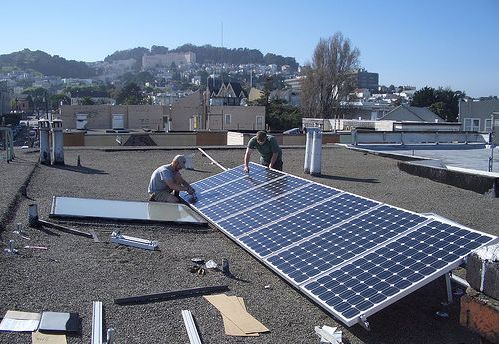Suppose two factories produce and sell identical widgets at $1 each.
Now, suppose a law is passed to provide one of those factories with $9 of additional revenue per widget.
Clearly, this is law will distort markets. The $10 widget manufacturer will attract more investors and it will lobby hard to preserve that law. Meanwhile, the $1 manufacturer will struggle. If it survives, it will be through cost control and niche markets.
After a few years of this, the $1 manufacturer may well have the better product, given their focus and discipline, while the $10 manufacturer will likely have the better political access.
This scenario pretty well describes clean energy markets today, with solar PV playing the role of the $10 widget maker. As a result, the solar PV industry is exposed to massive regulatory risk, while capital flows that would otherwise bring a host of other less-risky and more cost-effective technologies forward are distorted.
Such are the inherent failures of path-based regulation. As long as we confuse support for a path (e.g., solar power) with support for a goal (e.g., CO2 reduction), the environment, the economy, and our political discourse will suffer.
- The environment loses because capital is finite: the more we spend per unit of CO2-free electricity, the less CO2 we will reduce.
- The economy loses because failure to deploy the lowest cost clean generation technologies raises energy prices unnecessarily, leaving less money in all of our pockets, for no social benefit.
- Political discourse loses because these path-based approaches put clean energy advocates in direct opposition to cheap energy advocates, creating needless conflict.
So why do we favor path-based rules? Hubris, in part. No matter how bad our track record, we’re sure that this time we’ve got it right.
But hubris only starts this process; baser motivations keep it going. Once path-based rules are passed, they create their own constituency. There are a lot of fortunes (and egos) that depend on the preservation of our path-based model. A goal-based model would be good for the environment and the economy, but the transition would be emotionally painful, inasmuch as it forces us to acknowledge that what’s good for the solar industry isn’t necessarily what’s good for America.
The numbers
Since the benefits from any carbon-free power source are only realized when MWh are generated, it’s appropriate to compare revenue streams on a $/MWh basis. That requires a bit of math, because not all the incentives we provide to clean energy are MWh-denominated.
Any clean generation technology has access to one or more of the following revenue streams:
- Brown power displacement: Before any green attributes, there is revenue associated with the displacement of traditional power sources. This may come in the form of displaced retail purchases or a wholesale transaction with a utility.
- Net-metering: Where it exists, net metering can provide qualifying technologies with the ability to realize full retail rate displacement for all MWh generated, regardless of local load.
- Tax credits: Some but not all clean technologies are eligible for investment tax credits, ranging from 10-30 percent of total capital investment.
- Renewable energy credits: In the 29 states with renewable portfolio standards, eligible technologies can sell the renewable energy attributes of the power they generate.
Let’s now look at how these apply to locally-sited solar PV on a $/MWh basis. Brace yourself for some math!
U.S. average retail rates today are $98.90/MWh. In 43 states with net metering laws, this retail rate can be applied to 100 percent a PV array’s output. Solar also gets a 30 percent investment tax credit, and if we assume $6500/kW for the installed cost of the system, that works out to $1,950 per installed kW of capacity. Given a 15 year operating lifetime and a 20 percent annual capacity factor, each kW of installed solar PV capacity produces 26,280 kWh over its lifetime. Thus, the $1,950 tax credit is worth an additional $74.20/MWh (ignoring the time-value of money). Finally, while REC markets vary by state, renewable attributes can add an additional ~$25/MWh to a PV project.
Thus, the revenue available to an “average” PV installation is $98.90 + $74.20 + $25 = $198.10/MWh.
Now let’s look at geothermal. We can use the same math as above, but with four notable differences: a wholesale (rather than retail) brown power rate, a 10 percent ITC, a higher annual capacity factor, and a lower installed cost. At a $60/MWh wholesale rate, $3500/kW capital cost, a 95 percent annual capacity factor, and 20 year lifetime, that means that geothermal earns $87.10/MWh, or 44 percent of the income of the solar PV array. If we look only at the “green premium” paid per pollution-free MWh, the PV facility is earning 3.7 times the incentive of the geothermal installation.
Now let’s look the recycling of industrial waste energy. Like geothermal, it is a high-capacity factor technology that is eligible for a 10 percent investment tax credit. Capital costs average about $2500/kW and operating lifetimes run ~25 years. It is eligible for RECs in a few states, but only as a “tier 2” resource, which has historically kept it from earning any meaningful REC value. Finally, it is — by definition — nascent to industrial facilities and generally not eligible for net metering, so its revenue per unit of brown power is the retail rate paid by large industrials rather than the US average, typically about $50/MWh.
So with $50/MWh for the brown power and $250/(8760 x 95 percent x 25) = $1.20/MWh for the ITC, that yields just $51.20/MWh, or 26 percent of the value realized by the PV array.
Comparing just the green premium, a PV array earns 83 times the incentive per pollution-free MWh as the recycled energy facility.
But even these numbers are too low!
Now, the problem: I’m not aware of anyone building the technologies described above at those prices, for the simple reason that those prices aren’t high enough to attract capital investment once the operating costs are taken into account. The irony, of course, is that the revenue streams available to solar PV are more than sufficient to attract investment in other clean generation options — but that’s irrelevant, since those streams aren’t available to the other options.
Importantly, every clean technology can make a legitimate case that they can’t get enough revenue to attract capital. But who cares? The goal isn’t to deploy solar, geothermal, recycled energy, or any other specific technology — it’s to lower the damned CO2 as quickly and as cheaply as possible. When one person is trying to chop down a tree with a log splitter and another is trying to chop wood with a handsaw, the relevant discussion is not who deserves the bigger tool, but how to get the job done. Path-based regulations encourage the wrong discussion.
My (unscientific) perusal of recent public disclosures on clean energy projects suggests that recycled energy projects that are actually getting built are realizing revenues of at least $70/MWh, geothermal projects don’t come on line at anything less than $100/MWh, and PV needs over $400/MWh. Meanwhile, utilities are telling their commissions that they can’t bring new coal on line for less than $130/MWh.
This ought to represent an opportunity. Green is cheaper than brown. Google’s RE < C has been vindicated. We can finally get serious about clean energy without compromising on the economy. But we don’t, because we’re so caught up in our path-based paradigm that the only conversation we have is about political tradeoffs and subsidies.
We can fix that if we shift to a goal-based framework. But that, in turn, requires that the environmental community focus exclusively on environmental protection, even if that focus comes at the expense of its favorite technologies.



